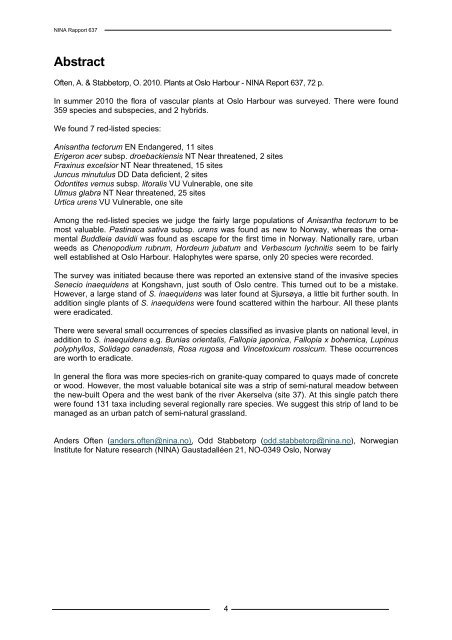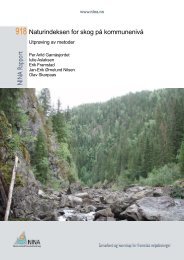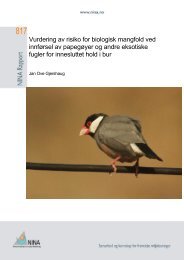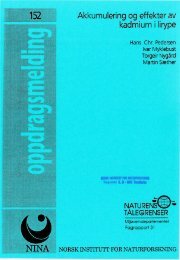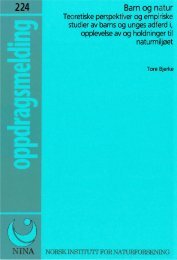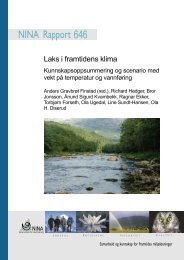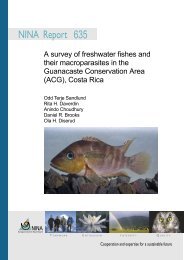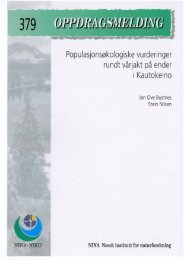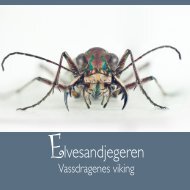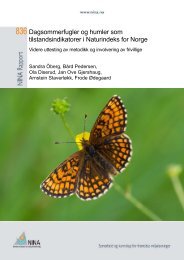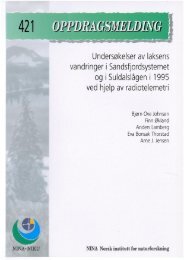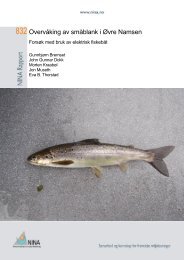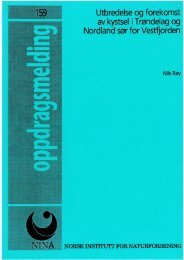You also want an ePaper? Increase the reach of your titles
YUMPU automatically turns print PDFs into web optimized ePapers that Google loves.
NINA Rapport 637<br />
Abstract<br />
Often, A. & Stabbetorp, O. 2010. Plants at <strong>Oslo</strong> Harbour - NINA Report 637, 72 p.<br />
In summer 2010 the flora of vascular plants at <strong>Oslo</strong> Harbour was surveyed. There were found<br />
359 species and subspecies, and 2 hybrids.<br />
We found 7 red-listed species:<br />
Anisantha tectorum EN Endangered, 11 sites<br />
Erigeron acer subsp. droebackiensis NT Near threatened, 2 sites<br />
Fraxinus excelsior NT Near threatened, 15 sites<br />
Juncus minutulus DD Data deficient, 2 sites<br />
Odontites vernus subsp. litoralis VU Vulnerable, one site<br />
Ulmus glabra NT Near threatened, 25 sites<br />
Urtica urens VU Vulnerable, one site<br />
Among the red-listed species we judge the fairly large populations of Anisantha tectorum to be<br />
most valuable. Pastinaca sativa subsp. urens was found as new to Norway, whereas the ornamental<br />
Buddleia davidii was found as escape for the first time in Norway. Nationally rare, urban<br />
weeds as Chenopodium rubrum, Hordeum jubatum and Verbascum lychnitis seem to be fairly<br />
well established at <strong>Oslo</strong> Harbour. Halophytes were sparse, only 20 species were recorded.<br />
The survey was initiated because there was reported an extensive stand of the invasive species<br />
Senecio inaequidens at Kongs<strong>havn</strong>, just south of <strong>Oslo</strong> centre. This turned out to be a mistake.<br />
However, a large stand of S. inaequidens was later found at Sjursøya, a little bit further south. In<br />
addition single plants of S. inaequidens were found scattered within the harbour. All these plants<br />
were eradicated.<br />
There were several small occurrences of species classified as invasive plants on national level, in<br />
addition to S. inaequidens e.g. Bunias orientalis, Fallopia japonica, Fallopia x bohemica, Lupinus<br />
polyphyllos, Solidago canadensis, Rosa rugosa and Vincetoxicum rossicum. These occurrences<br />
are worth to eradicate.<br />
In general the flora was more species-rich on granite-quay compared to quays made of concrete<br />
or wood. However, the most valuable botanical site was a strip of semi-natural meadow between<br />
the new-built Opera and the west bank of the river Akerselva (site 37). At this single patch there<br />
were found 131 taxa including several regionally rare species. We suggest this strip of land to be<br />
managed as an urban patch of semi-natural grassland.<br />
Anders Often (anders.often@nina.no), Odd Stabbetorp (odd.stabbetorp@nina.no), Norwegian<br />
Institute for Nature research (NINA) Gaustadalléen 21, NO-0349 <strong>Oslo</strong>, Norway<br />
4


